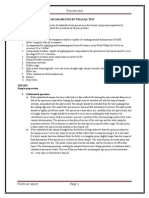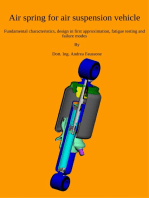Oedometer
Oedometer
Uploaded by
Daniel ShinnickCopyright:
Available Formats
Oedometer
Oedometer
Uploaded by
Daniel ShinnickOriginal Title
Copyright
Available Formats
Share this document
Did you find this document useful?
Is this content inappropriate?
Copyright:
Available Formats
Oedometer
Oedometer
Uploaded by
Daniel ShinnickCopyright:
Available Formats
SOIL MECHANICS LABORATORY
11. Oedometer Consolidation(Ref BS 1377 1990 Part 5)
1. Objective
This method covers the determination of the magnitude and rate of the consolidation of a saturated specimen of soil in the form of a disc confined laterally, subjected to vertical axial pressure, and allowed to drain freely from the top and bottom surfaces.
2.
Principles
In this test the soil specimen is loaded axially in increments of applied stress. Each stress increment is held constant until the primary consolidation has ceased. During this process water drains out of the specimen, resulting in a decrease in height which is measured at suitable intervals. These measurements are used for the determination of the relationship between compression (or strain) or voids ratio and effective stress, and for the calculation of parameters which describe the amount of compression and the rate at which it takes place.
Procedures 3.1 Apparatus
The consolidation apparatus, known as the oedometer, shall be of the fixed ring type and shall consist of : A consolidation ring of corrosion-resistant metal which shall completely and rigidly support and confine the soil specimen laterally. The ring shall have a cutting edge. The inside diameter shall be between 50 mm and 105 mm. The height of the ring shall be not less than 18 mm and not more than 0.4 times the internal diameter. Corrosion-resistant porous plates for placing at the top and bottom surfaces of the test specimen. Their porosity shall allow free drainage of water throughout the test but shall prevent intrusion of soil into their pores. A consolidation cell of suitable corrosion-resistant material within which is placed the consolidation ring containing the sample. Load is applied to the specimen through a rigid, corrosion-resistant loading cap fitted with a central seating. The cell shall be capable of being filled with water to a level higher than the top of the upper porous plate. A dial gauge referred to as the compression gauge. The gauge shall be supported for measuring the vertical compression or swelling of the specimen throughout the test. It shall be readable to 0.002 mm and shall have a travel of at least 10 mm. A loading device having a rigid bed for supporting the consolidation cell. A counterbalanced lever system, using calibrated weights in increments, is used for applying the vertical force to the test specimen. A timing device readable to 1 s. A balance readable to 0.1 g A watch glass, or metal tray, larger in diameter than the consolidation ring. Calibration of apparatus: Weigh the ring and the watch glass separately to 0.1 g. Measure the height of the consolidation ring to 0.05 mm at four or more equally spaced points and calculate the mean height, Ho. Measure the internal diameter of the ring to 0.1 mm in two perpendicular directions. Calculate the mean diameter and the area, A, in mm2. Preparation of specimen Prepare the specimen from an undisturbed sample of soil, taken either from a sample tube, or as an excavated block sample. The specimen may be obtained by extruding into the consolidation ring. Specimen measurements Place the specimen in its ring on the watch glass or tray and weigh immediately to 0.1 g. Determine the initial mass of the specimen, mo. Take a sample of soil similar to that in the ring for the determination of particle density, if required, and initial moisture content. A suitable form for recording these data is shown as form 5.A. Preparation and assembly of apparatus Before using the porous plates in a test, keep the plates saturated in deaerated water until required for use. Immediately before assembly in the consolidation cell remove free surface water with a tissue, ensuring that the pores remain saturated. Assembly of consolidation cell Place the bottom porous plate, centrally in the consolidation cell. Place the specimen contained in its ring centrally on top of the porous plate. Assemble the cell components so that the consolidation ring is laterally confined and in correct alignment. Place the top porous plate and loading cap centrally on top of the specimen. Assembly in load frame Place the consolidation cell in position on the bed of the loading apparatus. Adjust the counterbalanced loading beam so that when the load-transmitting members just make contact with the loading cap the beam is slightly above the horizontal position. Add a small weight to the beam hanger, sufficient to maintain contact. Clamp the compression gauge securely into position so that it can measure the relative movement between the loading cap and the base of the cell. Record the initial reading of the gauge.
13/09/2010 jpm 11oedometer
3.2 Test Procedure
Loading sequence. A range of pressures selected from the following sequence has been found to be satisfactory. 6, 12, 25, 50, 100, 200, 400, 800, 1 600, 3 200 kPa. A typical test comprises four to six increments of loading, each held constant for 24 h, and each applied stress being double that of the previous stage. Loading is removed in a smaller number of decrements. The initial pressure depends on the type of soil. Application of pressure Record the compression gauge reading as the initial reading for the load increment stage, di. Apply the required pressure to the specimen at a convenient moment (zero time) by adding the appropriate weights to the beam hanger without jolting. Remove the weight used for the seating load. Fill the consolidation cell with water after applying the pressure. Take readings of the compression gauge at suitable intervals of time. The following periods of elapsed time from zero are convenient. A suitable form for recording the readings is shown as form 5.B 0, 10, 20, 30, 40, 50 s 1, 2, 4, 8, 15, 30 min 1, 2, 4, 8, 24 h Plot the compression gauge readings, manually, against the square root time, while the test is in progress. Maintain the pressure until the plotted readings indicate that primary consolidation has been completed. A period of 24 h under one pressure is generally adequate. Record the daily maximum and minimum temperatures in the vicinity of the test apparatus to the nearest 1 C. Record the time and compression gauge reading at the termination of the load increment stage, df. This reading becomes the initial reading for the next stage. Increase the pressure to the next value in the selected sequence and repeat recording readings and plotting. Repeat for further stages of the sequence of loading, making at least four stages in all. The maximum pressure applied to the specimen shall be greater than the effective pressure which will occur in situ due to the overburden and proposed construction. Unloading: For this laboratory exercise, no unloading curve is required. Dismantling: Drain off the water from the cell. Remove the load from the specimen and remove the consolidation cell from the apparatus. Dismantle the cell, and weigh the specimen in its ring on the weighed watch glass or tray. Transfer the specimen and ring on the watch glass or tray to the oven, dry the specimen to constant mass and determine the dry mass of the specimen 0.1 g (md).
3.3 Calculations and plotting
General data. (form 5.A) Calculate the initial moisture content, wo (in %), from the specimen trimmings. Calculate the initial bulk density, (in Mg/m3), from the equation: =
m0 x1000 AH 0 100 100 + w0
Where mo is the initial mass of the specimen (in g); A is the area of the specimen (in mm2); Ho is the initial height of the specimen (in mm). Calculate the initial dry density, d (in Mg/m3), from the equation: d =
To plot void ratio against pressure, calculate the initial voids ratio, eo, fromthe equation: eo=
s 1 d
Where s is the particle density (in Mg/m3). The initial degree of saturation, So, may becalculated as a percentage from the equation: So=
w0 s This value indicates whether the test specimen is fully saturated initially. e0
Compressibility characteristics: may be illustrated by plotting the compression of the specimen (in terms of voids ratio, the actual thickness, or the strain expressed as a percentage reduction in thickness referred to the initial thickness )as ordinate on a linear scale against the corresponding applied pressure p (in kPa), as abscissa on a logarithmic scale (form 5.C). Calculate and plot voids ratios and compressibility data as follows.(form 5.D). Calculate the equivalent height of solid particles, Hs (in mm), from the equation: Hs=
H0 1 + e0
Calculate the height of the specimen, H (in mm), at the end of each loading or unloading stage from the equation: where H is the cumulative compression of the specimen (reduction in height) from the initial H = H0-H height as recorded by the compression gauge. Calculate the voids ratio, e, at the end of each loading or unloading stage, if required, from the equation; e =
H Hs Hs
Calculate the coefficient volume compressibility, mv (in m2/MN), for each loading increment from the equation: mv =
H 2 H 1 1000 H 1 p2 p
where: H1 is the height of the specimen at the start of a loading increment (in
mm); H2 is the height of the specimen at the end of that increment (in mm); p1 is the pressure applied to the specimen for the previous loading stage (in kPa); p2 is the pressure applied to the specimen for the loading stage being considered (in kPa). Coefficient of consolidation. (form 5.D ) Square root time curve-fitting method. (See Figure 3.) Plot the readings for one increment of compression gauge against the square root of the corresponding time. Draw the straight line of best fit to the early portion of curve (usually within the first 50 % of compression) and extend it to intersect the ordinate of zero time. This intersection represents the corrected zero point, (this correction is most marked in the first increment, and may not ve present at all in the later increments) denoted by d0. Draw the straight line through the d0 point which at all points has abscissae 1.15 times as great as those on the best fit line. The intersection of this line with the laboratory curve gives the 90 % compression point, d90.Read off the value of t90 from the laboratory curve corresponding to the d90 point and calculate the value of cv (in m2/year), from
0.111H 2 the equation: cv= t 90
Report
Group membership, date and weight and identifiers of samples must be recorded, as well as observed readings, calculations and results, on the sheets from BS1377 Part 5
You might also like
- Consolidation TestDocument29 pagesConsolidation Testshahrolhazrien100% (7)
- Consolidation Test: The University of Hong Kong Department of Civil Engineering Soil Mechanics - CIVL2006Document20 pagesConsolidation Test: The University of Hong Kong Department of Civil Engineering Soil Mechanics - CIVL2006Nicholas Kwong100% (1)
- IT 160 Ch. 8 Activities WorksheetDocument25 pagesIT 160 Ch. 8 Activities WorksheetZak AliNo ratings yet
- Chemiluminescence As Diagnostic Tool A ReviewDocument26 pagesChemiluminescence As Diagnostic Tool A ReviewDian AmaliaNo ratings yet
- Triaxial Test: Consolidated UndrainedDocument9 pagesTriaxial Test: Consolidated UndrainedNguyễn Hòa100% (1)
- Triaxial Test 2850Document2 pagesTriaxial Test 2850Mostafa MagdyNo ratings yet
- Uu TestDocument15 pagesUu TestMin MiynNo ratings yet
- Triaxial TestDocument14 pagesTriaxial TestSi Rerumpai LautNo ratings yet
- Cid CiuDocument4 pagesCid CiuRazakMaidenNo ratings yet
- Triaxial TestDocument6 pagesTriaxial TestUtsav ParsanaNo ratings yet
- Oedometer and Direct ShearDocument58 pagesOedometer and Direct ShearGloria AtwebembeireNo ratings yet
- Undrained Triaxial TestDocument7 pagesUndrained Triaxial TestadityatheaaaNo ratings yet
- Consolidation Test Reviwed 2023Document9 pagesConsolidation Test Reviwed 2023Zaituni SuleimanNo ratings yet
- Test 09Document6 pagesTest 09Ateafac Anastasia NjuafacNo ratings yet
- Consolidation TestDocument3 pagesConsolidation TestAnuradha GunawardhanaNo ratings yet
- Job # 8: Consolidation Test - (Oedometer Test) : TheoryDocument6 pagesJob # 8: Consolidation Test - (Oedometer Test) : Theorysimply greenNo ratings yet
- CVG3109 - Lab - Consolidated Drained Tests For Sand - 2014Document11 pagesCVG3109 - Lab - Consolidated Drained Tests For Sand - 2014Rhedo.AbdNo ratings yet
- 1.103 Civil Engineering Materials Laboratory (1-2-3)Document5 pages1.103 Civil Engineering Materials Laboratory (1-2-3)prieten20006936No ratings yet
- GRP3 EXP11 Consolidation-Test-1Document18 pagesGRP3 EXP11 Consolidation-Test-1PEÑA, Malich ANo ratings yet
- Consolidation Test - (Oedometer Test)Document8 pagesConsolidation Test - (Oedometer Test)saleem razaNo ratings yet
- SOIL POLLUTION - PPTX Presentation - PPTX Presentation SlideDocument70 pagesSOIL POLLUTION - PPTX Presentation - PPTX Presentation SlideApugo ifeanyichukwuNo ratings yet
- Consolidated Undrained Triaxial Compression Test For Undisturbed SoilsDocument9 pagesConsolidated Undrained Triaxial Compression Test For Undisturbed SoilsMasriflin TandeanNo ratings yet
- Soil Testing TriaxialDocument50 pagesSoil Testing TriaxialBekele AmanNo ratings yet
- Triaxial TestDocument4 pagesTriaxial TestLaxmikant KadamNo ratings yet
- G5 Direct ShearDocument5 pagesG5 Direct ShearFairiey Izwan AzaziNo ratings yet
- Experiment 4 TriaxialDocument8 pagesExperiment 4 TriaxialAnonymous t73KJjuMQYNo ratings yet
- Geoinformatics (2) ..Document12 pagesGeoinformatics (2) ..Dinesh SNo ratings yet
- TMH-6 - ST10Document10 pagesTMH-6 - ST10ATHOLSCHWARZNo ratings yet
- Unconfined Compression TestDocument4 pagesUnconfined Compression TestRajat KotwalNo ratings yet
- Mirpur University of Science and Technology Mirpur AJK Civil Engineering Department Geotechnical Engineering LabDocument4 pagesMirpur University of Science and Technology Mirpur AJK Civil Engineering Department Geotechnical Engineering LabShheryar BismilNo ratings yet
- Consolidation Test: 1. ObjectiveDocument6 pagesConsolidation Test: 1. ObjectiveSwapan PaulNo ratings yet
- Test 12 ConsolidationDocument6 pagesTest 12 ConsolidationMuhammad Azeem Ashraf 139-FET/BSCE/F17No ratings yet
- Direct ShearDocument4 pagesDirect ShearMUHAMMAD RIAZ AHMAD 2009-CIV-140No ratings yet
- Triaxial Compression TestDocument17 pagesTriaxial Compression Testsajjad.ghazai2001No ratings yet
- Consolidation TestDocument8 pagesConsolidation TestOkello StevenNo ratings yet
- Performance of Tri-Axial Compression Test On Cohesive Soils Under Un-Consolidated Un-Drained ConditionDocument13 pagesPerformance of Tri-Axial Compression Test On Cohesive Soils Under Un-Consolidated Un-Drained ConditionMazharYasinNo ratings yet
- Triaxial Test: Xzdetermination of Shear Parameters by Triaxail TestDocument8 pagesTriaxial Test: Xzdetermination of Shear Parameters by Triaxail TestTenzinKesangNo ratings yet
- Consolidation Test - Lab ManualDocument5 pagesConsolidation Test - Lab ManualAmira SyazanaNo ratings yet
- Triaxial Test ProcedureDocument7 pagesTriaxial Test ProcedureMuazNo ratings yet
- Triaxial Compression TestDocument53 pagesTriaxial Compression TestAndyra Jaiz BadduNo ratings yet
- ExperimentDocument22 pagesExperimentnora tannakNo ratings yet
- MohrDocument12 pagesMohrJoseph JboyNo ratings yet
- Unconfined Compression TestDocument2 pagesUnconfined Compression TestMohamed FarahNo ratings yet
- Determination of Coefficient of ConsolidationDocument5 pagesDetermination of Coefficient of ConsolidationNarender CivilNo ratings yet
- UU Triaxial TestDocument11 pagesUU Triaxial Testprinces_anaNo ratings yet
- Theory:: Coefficient of Volume ChangeDocument8 pagesTheory:: Coefficient of Volume ChangeJohn Pierce GumapacNo ratings yet
- Swelling TestDocument5 pagesSwelling TestwoimonyetNo ratings yet
- Triaxial Test IntroductionDocument4 pagesTriaxial Test IntroductionAshadi Hamdan100% (3)
- Triaxial Test ReportDocument2 pagesTriaxial Test ReportSaptarshiNo ratings yet
- Lab Report ON Determinination of The Consolidation Properties of SoilDocument12 pagesLab Report ON Determinination of The Consolidation Properties of SoilRejjuwwal MehRaNo ratings yet
- Pressuremeter Test: Experiment No. 05Document24 pagesPressuremeter Test: Experiment No. 05rishav baishyaNo ratings yet
- Unconfined Compression TestDocument3 pagesUnconfined Compression TestThrisha SoquitosoNo ratings yet
- Consolidation Test Aim of The ExperimentDocument7 pagesConsolidation Test Aim of The ExperimentPaul Wyom ZakkaNo ratings yet
- LAB 14 - One-Dimensional Consolidation - Oedometer - Level 0 - 2ndDocument6 pagesLAB 14 - One-Dimensional Consolidation - Oedometer - Level 0 - 2ndAmirah ShafeeraNo ratings yet
- SKAB 2012 - G3 - RecordingDocument17 pagesSKAB 2012 - G3 - RecordingKu NurhanaNo ratings yet
- Spectral method for fatigue damage estimation with non-zero mean stressFrom EverandSpectral method for fatigue damage estimation with non-zero mean stressNo ratings yet
- A Treatise on Meteorological Instruments: Explanatory of Their Scientific Principles, Method of Construction, and Practical UtilityFrom EverandA Treatise on Meteorological Instruments: Explanatory of Their Scientific Principles, Method of Construction, and Practical UtilityNo ratings yet
- Modern Sensors HandbookFrom EverandModern Sensors HandbookPavel RipkaRating: 5 out of 5 stars5/5 (1)
- FCR Prima t2 Brochure 01 PDFDocument2 pagesFCR Prima t2 Brochure 01 PDFshoaibNo ratings yet
- Elderly Dependency in India: Findings From Census DataDocument14 pagesElderly Dependency in India: Findings From Census DataIJAR JOURNALNo ratings yet
- Display PDF PDFDocument128 pagesDisplay PDF PDFविरमपुर बनासकांठा गुजरात ईश्वरNo ratings yet
- RPH 2 EMERALD (DLP) Sel, Rab, JematDocument132 pagesRPH 2 EMERALD (DLP) Sel, Rab, JematNisa ADNo ratings yet
- Thunderstorm Power PointDocument17 pagesThunderstorm Power PointCrystal PennypackerNo ratings yet
- Mind SetDocument3 pagesMind Setinderr_23No ratings yet
- Test 2 Sem 1Document13 pagesTest 2 Sem 1brady47No ratings yet
- Manual FFHH Oaci (Ingles)Document335 pagesManual FFHH Oaci (Ingles)Pran Antonio EscobarNo ratings yet
- Design Organizations For The International Environment: Organization Theory and DesignDocument24 pagesDesign Organizations For The International Environment: Organization Theory and DesignNiraj KumarNo ratings yet
- Knowledge of Sericulture Extension Worke PDFDocument5 pagesKnowledge of Sericulture Extension Worke PDFTruyen NgoNo ratings yet
- Proj Guidelines TM2 6 7R00Document51 pagesProj Guidelines TM2 6 7R00rsirsi3742No ratings yet
- Elixir: Mix and OTPDocument108 pagesElixir: Mix and OTPBreno Douglas100% (1)
- STP1207 Eb.1415051 1 PDFDocument805 pagesSTP1207 Eb.1415051 1 PDFpaola100% (1)
- How To Take Care of An Egg Baby ProjectDocument3 pagesHow To Take Care of An Egg Baby Projectzzaentz0% (1)
- 06163389Document12 pages06163389sudhirkmnNo ratings yet
- Stem Design BriefDocument1 pageStem Design Briefapi-397898275No ratings yet
- Martin Nguyen: Education ExperienceDocument1 pageMartin Nguyen: Education ExperienceMartin NguyenNo ratings yet
- Unlock-The Petrophysics of Problematic ReservoirsDocument9 pagesUnlock-The Petrophysics of Problematic ReservoirsJose BarreroNo ratings yet
- Debate RubricDocument1 pageDebate Rubricapi-372321353No ratings yet
- Curriculum Map: First Quarter-Earth and Space Key Stage StandarsDocument13 pagesCurriculum Map: First Quarter-Earth and Space Key Stage StandarsLeendeen Grace Solis SesdoyroNo ratings yet
- Acronis Backup CloudDocument84 pagesAcronis Backup CloudMunesh JadounNo ratings yet
- How To Become A Successful Language LearnerDocument9 pagesHow To Become A Successful Language LearnerNadia KniftonNo ratings yet
- Transpersonal Psychology As A Science: October 2018Document25 pagesTranspersonal Psychology As A Science: October 2018Reyhan. ReyzNo ratings yet
- Heat Loss in FinsDocument26 pagesHeat Loss in FinsRemo Ram100% (1)
- 2015 Bookmatter WeightingMethodsAndTheirEffectDocument59 pages2015 Bookmatter WeightingMethodsAndTheirEffectPietroRafaelFerreiraNo ratings yet
- Water Resources Engineer, Hydraulic Engineer, Civil EngineerDocument2 pagesWater Resources Engineer, Hydraulic Engineer, Civil Engineerapi-76789366No ratings yet
- SIMATIC WinCC Flexible - EN2008Document28 pagesSIMATIC WinCC Flexible - EN2008Ashok MoreNo ratings yet
- BBS Second Vision SummaryDocument66 pagesBBS Second Vision Summarykcjiban144No ratings yet

























































































